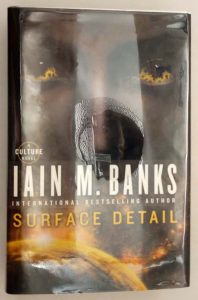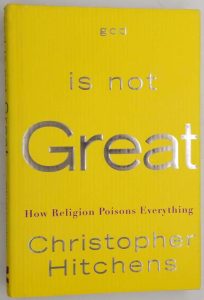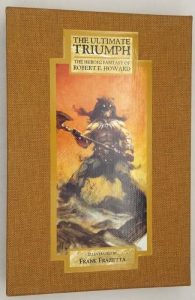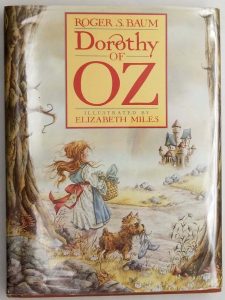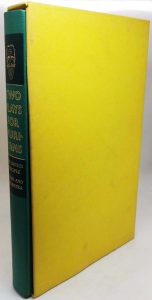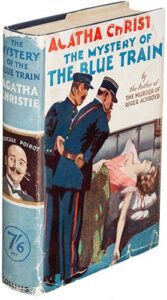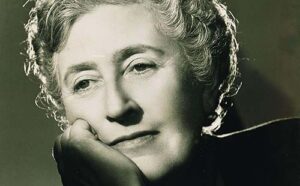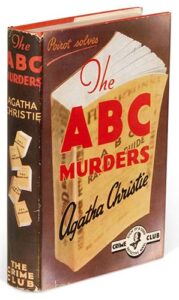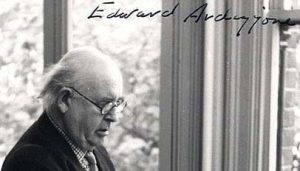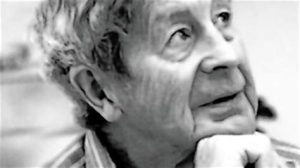Munro Leaf – American author and illustrator, 1905-1976
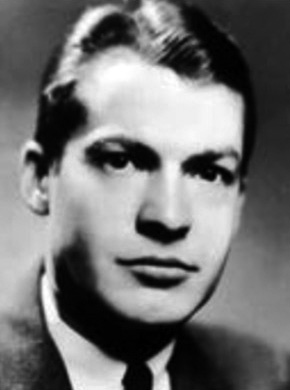
American author and illustrator, 1905-1976. During his forty-year career in children’s literature, Munro Leaf wrote and illustrated nearly forty books. He is best known as the creator of The Story of Ferdinand (1936), a modern juvenile classic that has charmed children worldwide for more than half a century.
Unforgettably paired with Robert Lawson’s black-and-white etchings, Leaf’s beloved tale of a peaceful Spanish bull ranks significantly in the field of American children’s literature as the first picture book to be labeled subversive, as well as an exemplary, seamless union of text and art.
Born in Maryland, Munro Leaf obtained degrees from the University of Maryland and Harvard University. He taught secondary school, then worked as editor and director for Frederick A. Stokes Company, a publishing firm in New York. His first children’s book, Grammar Can Be Fun (1934), came about because he overheard a mother lecturing her young son about the inappropriateness of saying “ain’t.”
Using stick figures, Leaf illustrated the didactic yet humorous text, which is meant to entertain as well as edify. Grammar Can Be Fun earned critics’ acclaim; it also launched Leaf’s “Can Be Fun” series, in which he wrote and illustrated nine equally successful titles whose topics range from health, safety, and manners to classroom subjects such as arithmetic, history, and science.
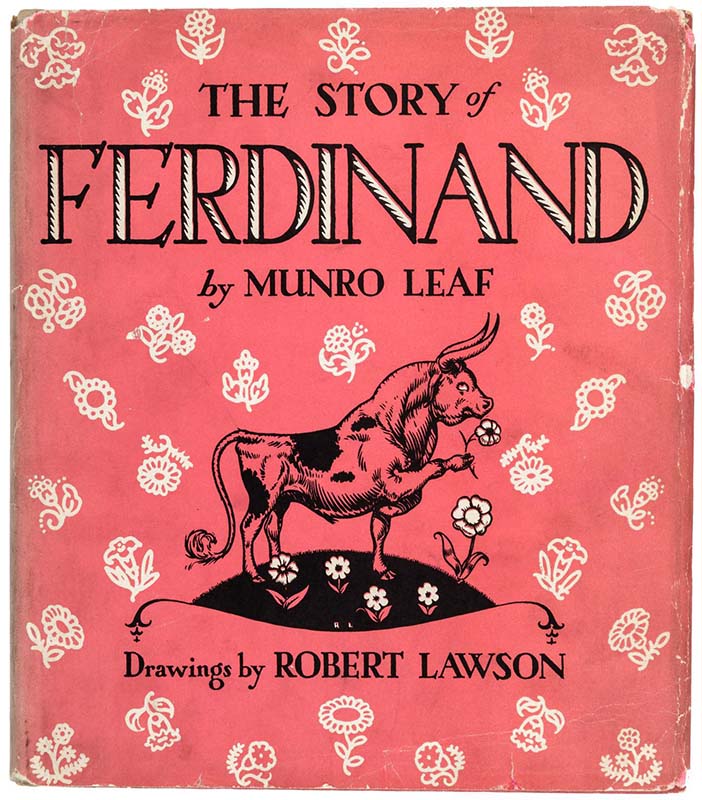
Munro Leaf garnered universal fame when he wrote The Story of Ferdinand, his most successful and finest work. He penned the brief text on a yellow legal pad in less than an hour for Robert Lawson, his illustrator friend. Viking’s gifted juveniles editor, May Massee, immediately accepted the collaboration and, in the fall of 1936, published the story of gentle Ferdinand, a young bull in rural Spain who prefers solitude and smelling flowers to the company of his fellow ruffian bulls.
When stung by a bee, Ferdinand’s antics are misinterpreted by scouts as belligerent behavior, and they quickly transport him to Madrid for a bullfight. In the arena, sanguinary spectators watch a phalanx of banderilleros, picadors, and the chivalrous matador readying for battle. But once in the ring, Ferdinand sees only the floral decorations adorning the ladies’ hair and tranquilly succumbs to his favorite pastime: smelling flowers. Taken home to his pasture, Ferdinand returns to the quietude and contentment that his special cork tree and flowers offer him.
Ferdinand created a global controversy overnight. The Story of Ferdinand was denigrated and banned in civil war-torn Spain, scorned and burned as propaganda by Hitler, and labeled in America as promoting fascism, anarchism, and communism. Others heralded the innocent bovine as an international emblem of pacifism. Leaf rebutted the attacks, stating that he wrote the story simply to amuse young children.
With more than sixty foreign-language translations, the never-out-of- print title still enjoys widespread popularity. Leaf’s ability to establish a strong character and comic situation with so few words is extraordinary; so, too, is Robert Lawson’s gift at interpreting Leaf ’s understated humor with spirited images that accurately reflect the emotions portrayed in the text. Both talents combine inseparably to craft a perfect picture book.
Leaf and Robert Lawson’s second collaboration, Wee Gillis (1938), also received wide critical acclaim. A small, orphaned lad who lived neither in the Highlands of Scotland nor in the Lowlands, but halfway between, Wee Gillis warms children’s hearts just as humorously as Ferdinand does; Lawson’s black-and-white etchings won the critics’ hearts, too, and they named Wee Gillis as a 1939 Caldecott Honor Book.
The third of Leaf s notable collaborations—this time with illustrator Ludwig Bemelmans—produced Noodle (1937), a happy, moral tale about a dachshund who, even after a visit from a magical wish-granting dog-fair, judiciously chooses to remain exactly the same size and shape he is.
Leaf once said,
“Early on in my writing career I realized that if one found some truths worth telling they should be told to the young in terms that were understandable to them.”
Few, if any, characters in American children’s picture books are better understood or more loved by multitudes around the world than Ferdinand, Leaf’s reluctant hero who likes “to sit just quietly and smell the flowers.”
S.L.S.
Source: Childrens’s Books and their Creators, Anita Silvey.
Munro Leaf Works
- Grammar Can Be Fun, New York, Frederick A. Stokes, 1934.
- Lo, the Poor Indian, New York, Leaf, Mahoney, Seidel & Stokes, 1934.
- The Boy Who Would Not Go to School: Robert Francis Weatherbee, New York, Frederick A. Stokes Co., 1935.
- Manners Can Be Fun, New York, Frederick A. Stokes, 1936.
- Leaf, Munro, Robert Lawson (illustrator). The Story of Ferdinand, New York, Viking Press, 1936.
- Leaf, Munro, Ludwig Bemelmans (illustrator) Noodle, New York, Frederick A. Stokes, 1937.
- Leaf, Munro, Robert Lawson (illustrator). Wee Gillis, New York, Viking Press, 1938.
- Leaf, Munro, Dick Rose (illustrator) Listen Little Girl, Before You Come to New York, New York: Frederick A. Stokes Co., 1938.
- Leaf, Munro, Disney Illustrators. Walt Disney’s Ferdinand the Bull, New York, Dell Publishing, 1938.
- The Watchbirds, New York, Frederick A. Stokes, 1938.
- Safety Can Be Fun New York, Frederick A. Stokes, 1938.
- Fair Play, New York, Frederick A. Stokes, 1939.
- More Watchbirds: A Picture Book of Behavior, New York, Frederick A. Stokes Company, 1940.
- John Henry Davis, New York, Frederick A Stokes, 1940.
- Fly Away, Watchbird: A Picture Book of Behavior, New York, Frederick A Stokes Company, 1941.
- Leaf, Munro, Robert Lawson (illustrator). Aesop’s Fables, New York, Heritage Press, 1941.
- Munro Leaf’s Fun Book, New York, Frederick A. Stokes Company, 1941.
- Leaf, Munro, Robert Lawson. The Story of Simpson and Sampson, New York, Viking Press, 1941.
- A War-Time Handbook for Young Americans, Philadelphia, Frederick A. Stokes Company, 1942.
- My Book to Help America, Racine, WI: Whitman Publishing Co, 1942.
- Leaf, Munro, Theodor Seuss Geisel (illustrator). This Is Ann, She’s Dying to Meet You., US Government War Department, Washington, 1943.
- Health Can be Fun, New York, J.B. Lippincott, 1943.
- Gordon The Goat, Philadelphia and New York, J.B. Lippincott Co., 1944.
- 3 and 30 Watchbirds: A Picture Book of Behavior, Philadelphia, J.B. Lippincott Co., 1944.
- Let’s Do Better, J.B. Lippincott Co., 1945.
- Calvert, John (Munro Leaf) Garrett Price (illustrator). Gwendolyn the Goose, Random House, 1946.
- How to Behave and Why, Philadelphia, J.B. Lippincott, 1946.
- Flock of Watchbirds, New York, J.B. Lippincott, 1946.
- Who Is the Man Against the Marshall Plan, Committee for the Marshall Plan, 1947.
- Leaf, Munro, Frances Tipton Hunte (Illustrator). Boo, Who Used to Be Scared of the Dark, New York, Random House, 1948.
- Sam and the Superdroop, New York, Viking Press, 1948.
- Menninger, William C. (M.D.); Leaf, Munro. You and Psychiatry, New York, Charles Scribner’s Sons, 1948.
- Arithmetic Can Be Fun, Philadelphia, J.B. Lippincott, 1949.
- History Can Be Fun, Philadelphia, Lippincott Co, 1950.
- The Danger of Hiding Our Heads, Committee on the Present Danger, 1951.
- Geography Can Be Fun!, Philadelphia, J.B. Lippincott, 1951.
- Reading Can Be Fun, Philadelphia, J.B. Lippincott, 1953.
- Lucky You, J.B. Lippincott, 1955.
- How to Behave and Why, J.B. Lippincott, 1955.
- Three Promises to You, Philadelphia: J.B. Lippincott, 1957.
- Science Can Be Fun, Philadelphia, J.B. Lippincott, 1958.
- The Wishing Pool, New York: J.B. Lippincott, 1960.
- Being an American Can Be Fun, Philadelphia, J.B. Lippincott. 1964.
- Turnabout, Philadelphia, J.B. Lippincott Company, 1967.
- I Hate You, Boston, Sterling Institute Press, 1968.
- Who Cares? I Do, New York, J.B. Lippincott, 1971.
- Metric Can Be Fun, Winnipeg, MB, Canada, J.B. Lippincott Company, 1976.
- Four and Twenty Watchbirds, Hamden, Connecticut, Linnet Books, 1990.
- How to Speak Politely and Why, Universe, 2005.
